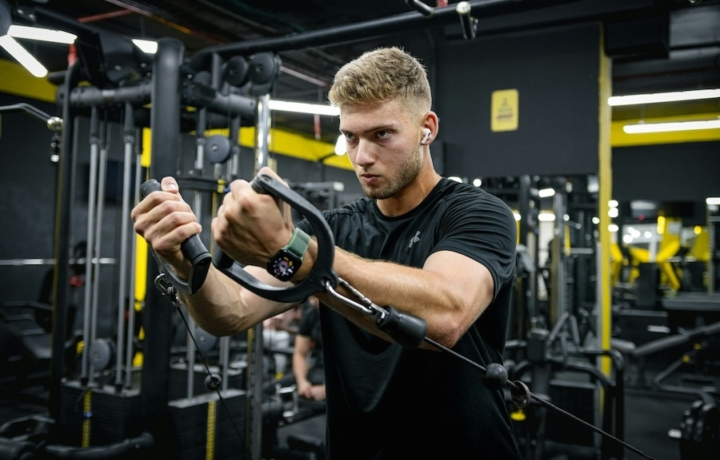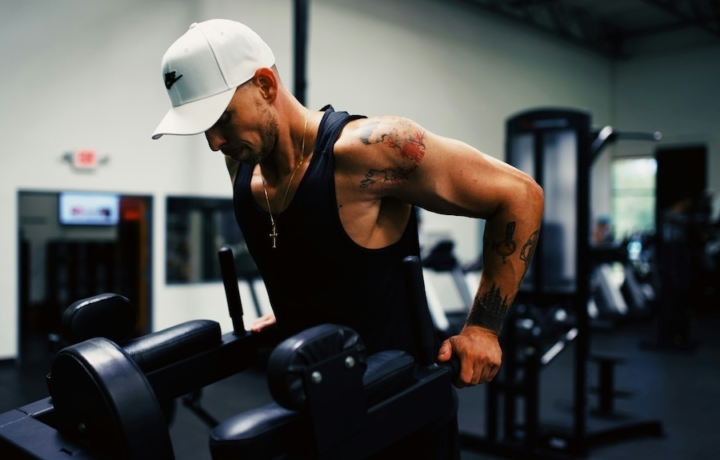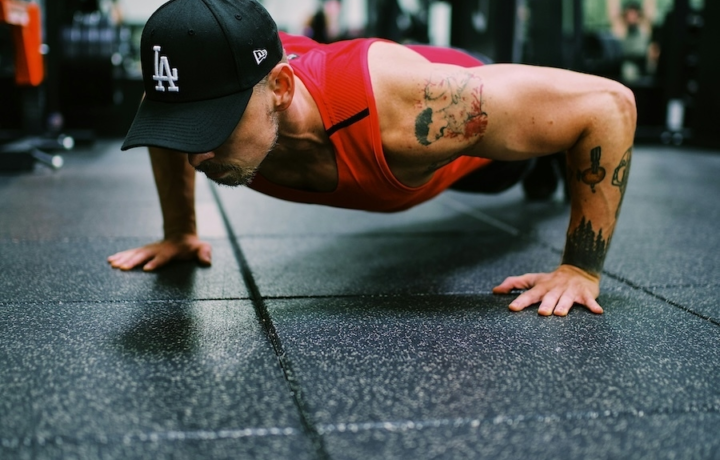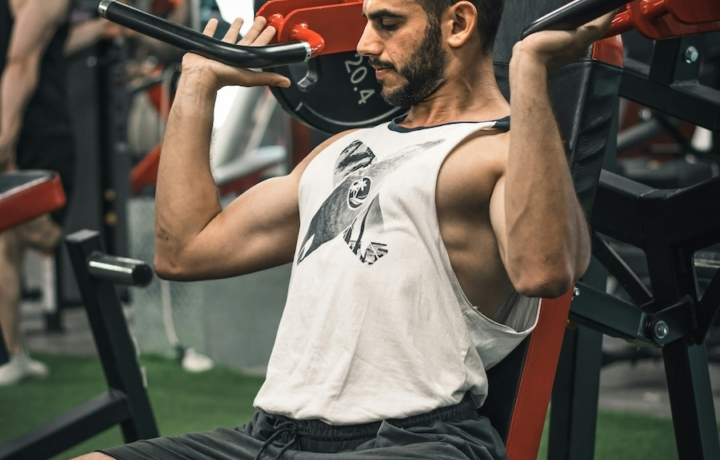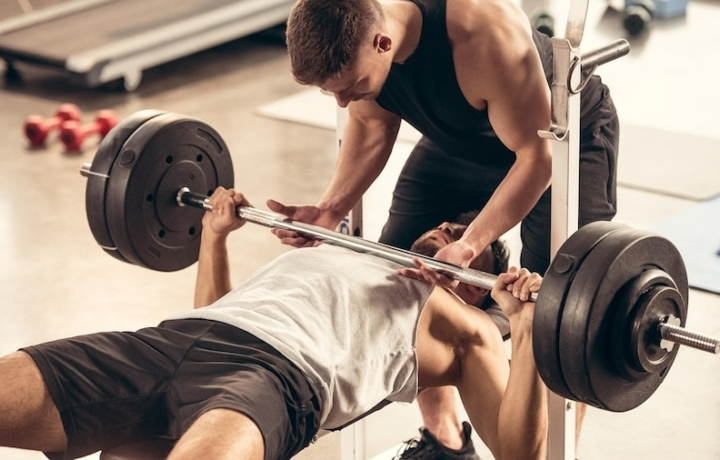Exercises to build lift, definition and lower chest power
Lower chest exercises
Lower chest development exercises help define the bottom edge of the chest and improve pushing strength at various angles. Whether you're training at home or in the gym, including lower chest work leads to better aesthetics, muscle activation, and overall performance in compound lifts.
Focus on
Pick your equipment

Barbell Decline Bench Press
The Barbell Decline Bench Press stands as a powerful compound movement that has earned its place in both bodybuilding and powerlifting circles. This intermediate-level exercise predominantly targets the lower portion of the pectoral muscles while engaging the triceps and front deltoids as crucial secondary movers. The unique angle of the decline bench shifts emphasis to the lower chest fibers, creating a more comprehensive pec development when programmed alongside flat and incline variations. Unlike its flat bench counterpart, the decline position reduces shoulder strain for many lifters while allowing for potentially heavier loads due to the shortened range of motion and advantageous leverage. This makes it particularly valuable for strength enthusiasts looking to overload the pressing muscles with substantial weight. The mechanical efficiency of this movement often enables lifters to handle 5-10% more weight than they might on a traditional flat bench. For bodybuilders, the decline bench press delivers that coveted lower pectoral development and contributes significantly to creating a full, balanced chest appearance. The exercise promotes hypertrophy through substantial time under tension and the ability to handle challenging loads. Meanwhile, powerlifters appreciate the carryover strength benefits to competition bench pressing, as the decline variation can help overcome sticking points and build pressing power. Research suggests that EMG activity in the lower pectoral region is notably higher during decline pressing compared to flat or incline variations, confirming its effectiveness for targeting this specific area. This makes it an excellent option for those looking to bring up lagging lower chest development or simply add variety to their pressing movements. While sometimes overlooked in favor of its flat and incline siblings, the decline bench press delivers remarkable strength and muscle-building benefits when properly programmed. Whether incorporated as a primary movement or as an accessory exercise, it offers unique advantages that can help intermediate lifters continue progressing toward their physique and performance goals.

Decline Push Up
The Decline Push Up stands as a powerful progression from the traditional push up, specifically designed to shift more emphasis onto the upper chest muscles while still engaging the triceps and anterior deltoids. This bodyweight movement represents an intermediate-level challenge that belongs in any serious strength-building or bodybuilding regimen, and can be seamlessly incorporated into high-intensity interval training sessions for enhanced cardiovascular benefits alongside muscular development. Unlike the standard push up that distributes tension relatively evenly across the pectoral region, the decline variation places your feet above your head, creating an angle that increases the load on your upper chest fibers. This mechanical advantage makes it particularly effective for developing that coveted chest shelf that many fitness enthusiasts pursue. The exercise's beauty lies in its simplicity – requiring no specialized equipment beyond an elevated surface – while delivering results comparable to decline bench pressing. The biomechanics of this movement activate approximately 70% of your upper body pushing muscles, with primary tension directed through the pectoralis major, especially the clavicular head. Meanwhile, your triceps brachii work as crucial secondary movers, and your anterior deltoids assist throughout the motion, creating a comprehensive upper body pushing stimulus. The instability factor inherent in the position also recruits more core stabilization than machine-based alternatives. For those focused on strength development, the decline push up serves as an excellent progressive overload tool once standard push ups become too easy. The increased resistance created by the angle can help push through plateaus and stimulate new growth. Bodybuilders particularly value this movement for its ability to target the upper chest with precision, while HIIT enthusiasts appreciate how quickly it can elevate heart rate when performed with minimal rest periods. What truly sets the decline push up apart is its versatility across training modalities – whether you're pursuing pure strength, muscular hypertrophy, or conditioning, this exercise delivers measurable results while requiring minimal setup time and zero equipment costs.

Dumbbell Decline Fly
The Dumbbell Decline Fly is a targeted chest exercise that places unique emphasis on the lower portion of the pectoral muscles. Unlike flat bench variations, the decline position shifts the stress to the lower chest fibers, creating comprehensive development across the entire pectoral region. This isolation movement requires controlled movement patterns and proper stabilization to maximize effectiveness. While not as technically demanding as advanced chest movements, the Dumbbell Decline Fly sits firmly in the intermediate category. It requires a baseline of chest strength and proper body awareness to execute effectively. The decline position introduces an element of complexity that beginners might find challenging, particularly in maintaining proper shoulder positioning and preventing the dumbbells from drifting too far forward. The star of this exercise is undoubtedly the pectoralis major, with particular emphasis on the lower sternal portion. The wide arc motion creates significant tension across the chest fibers, especially at the stretched position. While the anterior deltoids and serratus anterior act as secondary supporters, the pecs handle the majority of the workload during proper execution. Bodybuilders prize the Dumbbell Decline Fly for its ability to create detailed chest separation and lower pec development. The exercise allows for intense focus on muscle contraction and stretch, key components for hypertrophy. When incorporated into higher-rep schemes (8-15 repetitions), it serves as an excellent finishing movement to fully exhaust the chest after compound pressing exercises. Though primarily known for muscle development, consistent performance of Decline Flys contributes significantly to functional pressing strength. The exercise builds stabilizing strength through the chest, shoulders, and supporting musculature. This translational benefit carries over to improved performance in compound movements like bench press variations and pushups, creating a more balanced and powerful upper body.

Push Up
The push-up stands as one of the most effective bodyweight exercises in fitness, perfect for beginners yet challenging enough for advanced athletes. This classic movement primarily targets your pectoral muscles (chest), while simultaneously engaging your triceps and anterior deltoids (front shoulders) as secondary muscle groups. What makes push-ups truly exceptional is their versatility across multiple training styles – they're equally valuable in high-intensity interval training (HIIT) circuits, traditional bodybuilding routines, or as part of an effective warm-up sequence. When incorporated into your fitness regimen consistently, push-ups deliver impressive results for both strength development and muscular endurance. For beginners, this foundational exercise establishes crucial upper body stability and proprioception before advancing to more complex movements. The beauty of push-ups lies in their accessibility – requiring no equipment and minimal space, they can be performed virtually anywhere, making them ideal for home workouts or travel situations when gym access is limited. Despite their simplicity, push-ups offer remarkable physiological benefits. The movement creates significant muscle tension across the chest, shoulders, and arms while simultaneously engaging your core as a stabilizer. This full-body integration makes push-ups surprisingly effective for improving functional strength that transfers to daily activities. For those focused on bodybuilding, push-ups can be programmed with various tempos and rep schemes to stimulate muscle growth, particularly when weighted variations are incorporated as strength improves. Beyond muscular development, push-ups place moderate stress on your cardiovascular system when performed in higher-rep protocols or HIIT formats, offering efficiency for those seeking both strength and conditioning benefits in limited workout time. Their scalability makes them suitable for virtually any fitness level – modifications can reduce intensity for beginners, while advanced variations can challenge even seasoned athletes. As you progress in your fitness journey, the push-up remains a reliable assessment tool for upper body pushing strength and a cornerstone movement pattern worth mastering.
Build pressing power and define the lower chest line
Training goals for lower chest development
Lower chest training emphasizes the muscles at the base of your chest, helping you complete your physique and improve function. These exercises use decline angles and downward pressing movements to apply mechanical tension where it’s often missed. The best lower chest exercises trigger growth through progressive overload, fiber recruitment, and controlled eccentric loading. Adding this focus improves symmetry, enhances strength in horizontal and decline pressing, and prevents plateaus by varying the stimulus in your chest routine.
Effective movements to sculpt and strengthen your lower chest
Best lower chest exercises for strength and shape
The best lower chest exercises include decline barbell bench press, decline dumbbell press, and dips. Chest dips especially target the lower fibers when you lean forward slightly during the movement. Cable crossovers from high to low and decline push-ups are great isolation movements. These exercises allow you to hit the lower chest from multiple angles and resistance types. A balanced routine includes both compound lifts for strength and isolation movements for definition and control.
Get results with machines, free weights, or bodyweight alone
Equipment options for training the lower chest
Lower chest exercises can be performed using barbells, dumbbells, cables, machines, or just your own bodyweight. Decline benches are ideal but not required: decline push-ups and dips offer great alternatives. Cables allow for precise movement paths, especially with high-to-low crossovers. If you're training at home, use resistance bands or perform push-ups with feet elevated to mimic a decline angle. Whatever you choose, the key is to apply consistent tension through the right movement arc.
How to program lower chest training for optimal results
Integrate lower chest exercises into your routine
Lower chest training fits well within push or chest-focused days. Start with compound movements like dips, decline push ups or decline presses, then move to isolation work such as cable crossovers. Most lifters benefit from training this area 1–2 times per week. Rotating angles and resistance styles helps avoid adaptation and boosts long-term progress. You can customize your plan in the app to include the best lower chest exercises for your setup and goals. Recovery, volume, and intensity should match your training phase.
Frequently asked questions about lower chest exercises
Train your lower chest 1–2 times per week, ideally with 48–72 hours between sessions. Adjust frequency based on recovery and overall chest volume.
Use both. Compound lifts like dips build strength, while isolation moves like crossovers and decline flys refine shape and symmetry.
The most effective lower chest exercises emphasize a downward pressing motion. Decline bench presses, either with a barbell or dumbbells, are excellent for building size and strength in the lower portion of the chest. Dips are another powerful option — especially when leaning slightly forward to increase lower chest engagement. Decline push-ups and cable crossovers performed from high to low angles also isolate the lower chest well. For best results, combine heavy compound lifts with higher-rep isolation movements to fully target the lower chest from multiple angles.
Yes, you can train your lower chest effectively at home using bodyweight exercises and minimal equipment. Decline push-ups, where your feet are elevated on a chair or step, shift the emphasis to the lower chest. You can also perform dips between two sturdy surfaces like chairs or a countertop corner, which activate the lower chest when you lean slightly forward. Resistance bands anchored overhead allow for high-to-low pressing or fly movements. With consistency and creativity, home workouts can deliver noticeable results for lower chest development.
Integrate lower chext exercises into full-body and split routines
